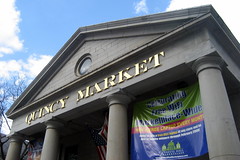Quincy Market, located in Faneuil Hall Marketplace, constructed from 1824–1826, was named in honor of Mayor Josiah Quincy, who organized its construction without any tax or debt. Historically used as a produce and grocer market, digging for a 1970s expansion uncovered evidence of animal bones, suggesting butchering work took place onsite too. Today the main building still provides food, albeit in the form of fast-food food court style restaurant stalls.
By the time Boston was incorporated as a city in 1822, downtown commercial demand grew beyond the capacity of Faneuil Hall necessitated expansion with an indoor pavilion of vendor stalls. Designed by Alexander Parris, the building was built immediately east of Faneuil Hall, which at the time was at the harbor's edge along the waterfront. Part of the harbor was filled with landfill to provide the plot.
The market is two stories tall, 535 feet long, and covers 27,000 square feet of land. Its exterior is largely traditional New England granite, with red brick interior walls, and represents the first large-scale use of granite and glass in post-and-beam construction. The east and west facades exhibit a strong Roman style, with strong triangular pediments and Doric columns. In contrast, the sides of the hall are more modern and American, with rows of rectangular windows. The building's shape is a long rectangle, providing for a long hallway down its center line. On the roof are eight evenly spaced chimneys, and a copper-clad dome in the center of the building, which covers an open common seating area and the major side entrances. In the center, surrounding the dome, is a two-story seating area.
Further street vending space is available against the outside walls of the building under a glass enclosure. More conventional retail space is provided on the second floor and in the basement level. The Comedy Connection currently occupies one of the second-floor spaces. Cheers Faneuil Hall occupies a space at the western end of the the Market, with a giftshop in the basement.
Flanking the main building in the marketplace are two equally long buildings (North Market and South Market) that expand the market space for more restaurants, specialty shops, and office spaces. Two further concave market buildings enclose a circular plaza at the market's west end. The open spaces at both the east and west ends of the marketplace are a common venue for various street performers, as well as street vendors. Most daytime visits to Quincy Market will encounter a large circular crowd of people standing around a juggler or other unique act.
National Register #66000784 (1966)
Suscribirse a:
Enviar comentarios (Atom)


No hay comentarios:
Publicar un comentario